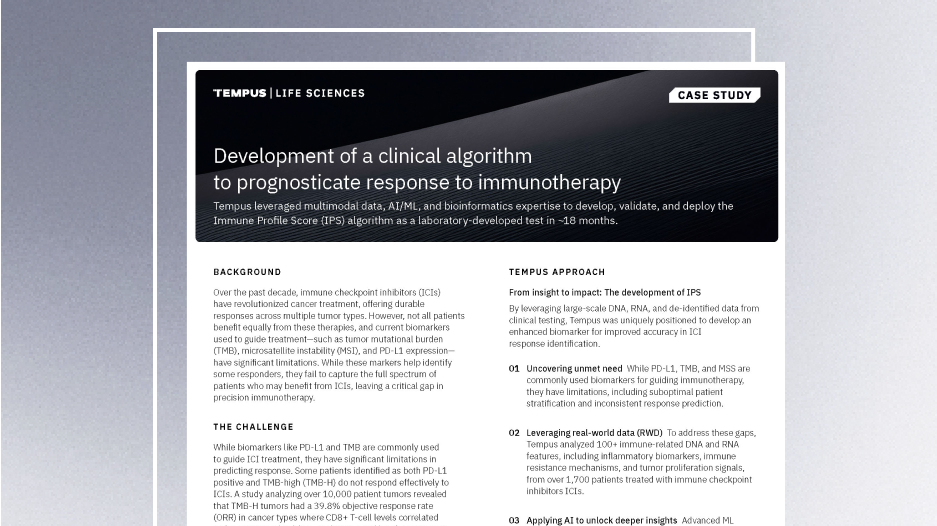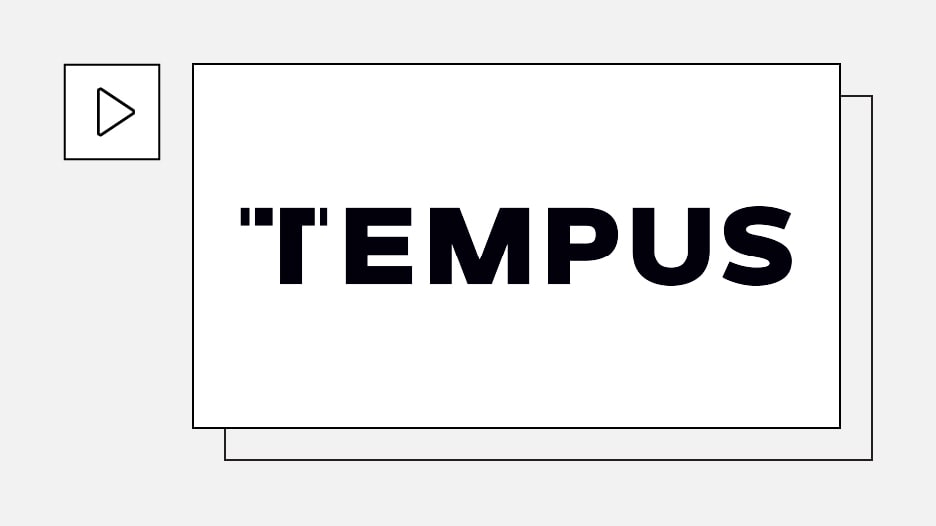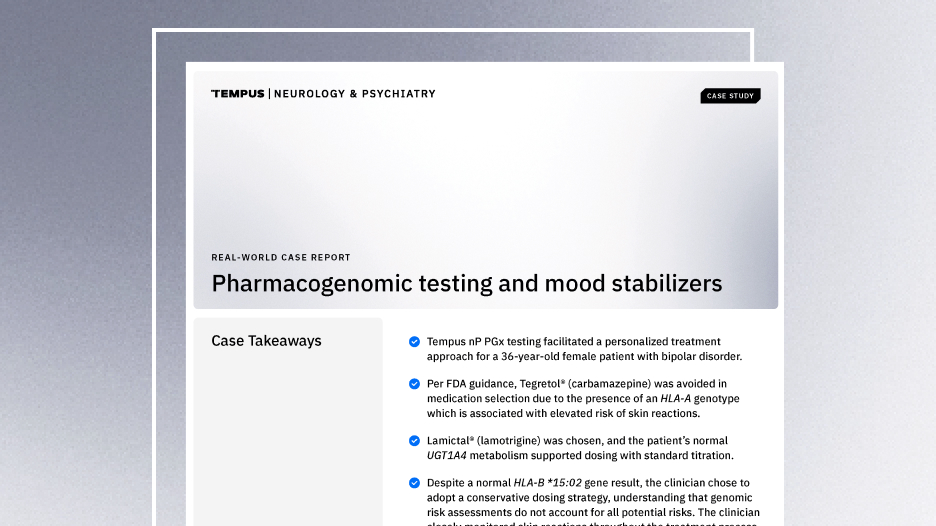-
PROVIDERS
Register now
Are you getting the full picture? A webinar series on the power of comprehensive intelligent diagnostics
-
LIFE SCIENCES
Enroll now
Tempus’ Patient-Derived Organoid ScreensEvaluate the efficacy of your preclinical compounds using fixed organoid panels designed for diverse therapeutic applications. Space is limited — enroll by June 30, 2025, to secure your spot.
-
PATIENTS
It's About Time
View the Tempus vision.
- RESOURCES
-
ABOUT US
View Job Postings
We’re looking for people who can change the world.
- INVESTORS
07/06/2023
5 things to know when navigating clinical development and regulatory pathways for CDx
Scientific and regulatory leaders from Tempus discuss how Tempus’ platform can enhance clinical development for CDx.
Authors
Kate Sasser, PhD
Chief Scientific Offficer, Tempus

Lauren Silvis
SVP, External Affairs, Tempus

Elaine Katrivanos
VP, Regulatory Affairs, Tempus

Chief Scientific Offficer, Tempus

Lauren Silvis
SVP, External Affairs, Tempus

Elaine Katrivanos
VP, Regulatory Affairs, Tempus

Tempus recently received pre-market approval (PMA) from the U.S. Food and Drug Administration (FDA) for xT CDX, a next-generation sequencing test for solid tumors. In a recent webinar, three scientific and regulatory leaders from Tempus met to discuss the approval and how the Tempus platform of data, clinical trial services, genomic testing, and artificial intelligence (AI) algorithms can enhance clinical development for companion diagnostics (CDx) and help bring treatments to the patients who need them faster.
Read on as we share five key learnings from the discussion between Dr. Kate Sasser (Chief Scientific Officer), Lauren Silvis (SVP, External Affairs), and Elaine Katrivanos (VP, Regulatory Affairs), including their advice for biopharma as they navigate clinical trials and regulatory pathways for novel CDx and therapeutics.
For their full discussion, watch the webinar recording here.
1. Multimodal data provides the fullest view of insights across the development cycle
Tempus partners with biopharma from drug discovery through phase IV to supplement all stages of drug development with data and technology.
“Tempus has a large, unified multimodal dataset with artificial intelligence and machine learning layered on top to uncover insights and drive precision medicine across healthcare,” Dr. Sasser said.
Our multimodal dataset – which combines data from next-generation sequencing genomic tests like xT CDx with clinical, molecular, genetic, and imaging data from radiology and pathology – enables biopharma researchers to gain the fullest view of all factors needed to inform their understanding of key patient populations. In early development, for example, researchers can run analyses on Tempus data to match patients to the right studies based on their molecular profiles.
“We can work with partners in a true end-to-end fashion, from the discovery phase through clinical development and, if successful, regulatory approval and launch tied to a CDx,” Dr. Sasser said.
2. Multimodal data provides the fullest view of insights across the development cycle
During CDx development, multimodal real-world data (RWD) enables speed and improves probability of technical success (PTS).
“Speed matters, especially when you’re developing drugs or diagnostics that you want to get to patients quickly,” Dr. Sasser said. “We help them identify biomarkers and targets of interest, dive into data to validate their hypotheses, then move rapidly into trial design to determine the right inclusion/exclusion criteria and patient population.”
In addition to reaching answers more rapidly, Tempus’s platform enables precision in patient selection. With a better understanding of which groups will benefit most from a drug, life science partners can design trials that are more likely to demonstrate efficacy – then translate those learnings to other development programs.
“I recommend taking an iterative approach to data,” Silvis said. “Data collection alongside a single clinical development program can help identify the subpopulations or targets of the future, or inform a much better understanding of the potential other avenues for drug development or real-world performance.”
3. Multimodal data provides the fullest view of insights across the development cycle
When life science organizations develop companion diagnostics and therapeutics – especially for novel products – it’s critical to start planning early in the development process. Dr. Sasser and Silvis shared that early collaboration can help researchers fine-tune study design, validate hypotheses, and use data strategically to position the new product for clinical and regulatory success.
“We find it most effective to start collaborating with life science partners early on, even during the discovery phase,” said Dr. Sasser. “We can use our multimodal dataset and genomic tests to help them assess the prevalence of a target in the patient population, that way they can move faster in the clinical trial stage.”
Using the Tempus multimodal dataset and genomic tests, Dr. Sasser explained, pharma can supplement and contextualize their own datasets to optimize trial operations.
Silvis spoke specifically about the regulatory implications of early planning. Especially when working with a novel product that doesn’t yet have an established regulatory pathway, early planning is essential.
“In my almost four years at Tempus, what’s been especially interesting is the early scientific collaboration, particularly when you’re looking at something really novel,” Silvis said. “At each phase, you can discuss plans of how to develop the right assay from a scientific and clinical perspective, as well as what the regulatory strategy should be at each phase so you can validate findings and gain an investigational device exemption (IDE).”
4. xT CDx’s broad panel is designed for future development of novel therapeutics and diagnostics
The xT CDx test includes tumor profiling across 648 genes, plus two companion diagnostic claims for cetuximab and panitumumab in colorectal cancer patients. Silvis explained that the broad panel establishes the foundation to pursue other CDx claims in partnership with biopharma sponsors.
“We did the work to establish a quality system, PMA, and level of validation,” Silvis said. “By including 648 genes, we can leverage what’s already in our PMA should other genes become areas of interest or potential targets for newer pharmaceuticals.”
Of course, any biopharma company looking to develop a new drug would need to conduct a clinical trial. But, as Silvis explained, the established regulatory platform, plus data structuring opportunities, provide a broader view of all potential avenues for drug development. And with some level of validation already done on an initial set of biomarkers, companies can take advantage of Tempus’s prior efforts to help bring novel therapeutics to cancer patients faster.
“We’re most excited to open up opportunities for newer targets,” Silvis said. “There is so much potential in oncology to take the different modalities and think about how they can be – either individually or in combination – used to identify new biomarkers and new targets for patients.”
5. CDx development projects are most strategic when partnerships are streamlined
Biopharma can leverage Tempus’ broad range of capabilities to collaborate across a range of clinical development initiatives – from genomic testing, to just-in-time trial design support, and more. This means that organizations can consolidate their partnerships model and receive end-to-end CDx support with a single partner.
“The best, most strategic collaborations are the ones where we work with partners in a broad way, leveraging multimodal data alongside our genomic sequencing offerings – including xT CDx – and even potentially pulling that through with our trial services,” Dr. Sasser said. “That allows our biopharma partners to go faster and tailor the approach depending on the drug of interest.”
Looking ahead
As Tempus continues to develop CDx together with biopharma, the panelists shared additional areas where they see opportunity for impact. Silvis shared that Tempus is continuing to build up regulatory offerings in DNA assays, followed by RNA and liquid biopsy. Dr. Sasser later shared in-progress work in the algorithm and liquid biopsy spaces.
“Today we have two different liquid biopsy LDT offerings, xF and xF+, which cover 105 genes and 523 genes, respectively. We’re also working on algorithms that sit on top of them to measure tumor burden for treatment response monitoring or to follow certain signatures from liquid biopsies. It’s a really exciting space, and we’re putting a lot of energy and resources toward moving this forward.”
Through the development of xT CDx and navigating its regulatory pathway, Tempus has accrued substantial knowledge regarding how to partner effectively with pharma companies on novel projects. “We understand the challenges in the drug development process, and we’re able to leverage diagnostics in work with life science partners very quickly, and then take that forward into the healthcare setting to help physicians make informed treatment decisions for their patients,” Dr. Sasser said.
If you have questions about xT CDx or how to navigate clinical development and regulatory considerations for your CDx products, please contact the Tempus team here.
xT CDx is a qualitative Next Generation Sequencing (NGS)-based in vitro diagnostic device intended for use in the detection of substitutions (single nucleotide variants (SNVs) and multi-nucleotide variants (MNVs)) and insertion and deletion alterations (INDELs) in 648 genes, as well as microsatellite instability (MSI) status, using DNA isolated from Formalin-Fixed Paraffin Embedded (FFPE) tumor tissue specimens, and DNA isolated from matched normal blood or saliva specimens, from previously diagnosed cancer patients with solid malignant neoplasms. The test is intended as a companion diagnostic (CDx) to identify patients who may benefit from treatment with the targeted therapies listed in the Companion Diagnostic Indications table in accordance with the approved therapeutic product labeling. Additionally, xT CDx is intended to provide tumor mutation profiling to be used by qualified health care professionals in accordance with professional guidelines in oncology for patients with previously diagnosed solid malignant neoplasms. Genomic findings other than those listed in the Companion Diagnostic Indications table are not prescriptive or conclusive for labeled use of any specific therapeutic product. xT CDx is a single-site assay performed at Tempus Labs, Inc., Chicago, IL.For the complete xT CDx label, including companion diagnostic indications and important risk information, please visit tempus.com/xt-cdx-label/.
-
04/02/2025
Development of a clinical algorithm to prognosticate response to immunotherapy
Discover how Tempus developed and deployed the Immune Profile Score (IPS)—a powerful algorithm that provides prognostic insights into patient outcomes following treatment with immune checkpoint inhibitors (ICIs)—in ~18 months. This case study highlights the AI-driven methodology, real-world validation, and the impact of IPS in precision oncology.
Read more -
03/25/2025
AI & ML in action: Unlocking RWD with GenAI through Tempus Lens
Discover how Tempus is equipping researchers with innovative AI solutions to fully leverage the potential of multimodal data. Gain insights from a panel of leaders across healthcare and life sciences as they discuss the impact of these advanced tools on delivering insights with speed.
Watch replay
Secure your recording now. -
03/11/2025
Case Report: Pharmacogenomic testing and mood stabilizers
This real-world case demonstrates how the Tempus nP pharmacogenomic test facilitated a personalized treatment approach for a patient with bipolar disorder.
Read more


